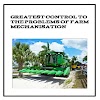Uses of Forage Plants
Forage Crops can be use for;
1. Livestock feed: Forage crops are usually used to feed livestock like cattle,goats,sheep etc. hay ,straw and silage can be produced from forages crops.
2. As cover crops: Most forage crops especially leguminous plants , serves as cover crop that add nutrients to soil and control weed growth.
3. Conservation of Soil Moisture: Forage crops especially the leguminous plants helps to conserve soil moisture by preventing evaporation.
4. Prevention of soil erosion: Forage plants helps to prevent erosion especially the leguminous plants.
5. As bedding materials: Some forage crops can be used for bedding of animals.
6. For roofing farmstead: Some forage crops like guinea grass, elephant grass are usually used for farmstead as a result of their strong stems and plenty leaves which helps to keep the house cool for livestock.
7. As green manure: Forage crops can be used as manure especially when they are young and it could be ploughed in the soil.
Types of Pastures
There are two types of pastures which includes:
1. Natural Pastures : Natural pasture is also referred to as natural grassland or rangeland. In this pasture,grasses ane legumes are grown naturally on their own without the use of fertilizers and farm animal fed upon i.e grasses are not planted by farmers.
Characteristics of Natural Pasture
1. It has good generative ability
2. Natural pasture contains poor quality grasses amd legumes.
3. It contains soil types that are low on fertility.
4. Forage crops in natural grassland can withstand trampling by farm animals.
5. The productivity of natural pasture is very low and it's resistant to drought.
6. It contains different types of forages, some of which the animals cannot eat.
7. New growth is stimulated by burning of other forages.
2. Artificial Pastures: This is also referred to as established or sowing of pastures.In this pasture, grasses and legumes are planted deliberately and are managed by man to be fed on by livestock.
Characteristics of Artificial Pastures
1. Since the forages are planted deliberately, high quality grasses and legumes will be grown.
2. It can withstand trampling by farm animals
3. Selected forages are grown in adequate proportion.
4. It is properly managed for high productivity of the forage crops e.g fertilization, irrigation and rotational grazing.
5. The pasture contains no weed except some shades tree.
Factors Affecting the Distribution of Pastures
Factors affecting the distribution of pasture can be grouped into three main classes:
(i) Climatic Factors: The type of climate in an area influence the types of vegetations in that particular area. For example, Sudan type of Climate favours the growth of grasses and legumes while the equitorial climate does not. Elements of climate which can directly influence the distribution of pastures are rainfall,wind, temperature, relative humidity , sunlight ,day length etc.
(ii) Soil or Edaphics Factors: This refers to the level of fertility of the soil. Poor soil does not support growth of pasture growth while land that is fertile support pasture growth.
(iii) Biotic Factors: Biotic factors like diseases,pest, parasites, predators generally influence the distribution of pastures.The activities of man such as bush burning and over grazing generally have adverse effects on the distribution of pastures.
Factors Affecting the Productivity of Pastures
The factors include:
1. Resistance to Trampling: This is ability of pastures to resist the continuous trampling by farm animals during grazing and still remain available to livestock to feed on.
2. Aggressiveness: This is the ability of pastures to fight with other weeds High aggressiveness ensures continuous availability of pasture crops.
3. Persistence: This is the ability of pastures crops to survive and spread by vegetative means
4. Resistance to Drought: Pastures which is able to withstand drought helps in maintaining high productivity and ensures that forages crops is available through out all the year.
5. Pests and Diseases: Absence of pests and diseases within pasture ensures there is increased productivity.
6. Seed Profuseness: Seed of pastures should be viable over a long period of time.Breeder must ensure that it should be easily propagated to ensure high productivity.
7. Accurate Stocking: An accurate number of animals should graze a specified area of pastures. Over grazing does not ensure increased productivity of pasture.
Establishment of Pasture
Before pasture can be successfully created, the following factors should be considered:
1. Comparability: The grass and legume mixture in the grassland must be compatible to each other.
2. Life Cycle of the Species: Annual forages should be planted with annual forages too.This is to ensure continuous availability of pastures.
3. Time of Maturity: Grasses and legumes to be established should be able to mature within the shortest period of time .
4. Adaptation to Environment: Forages should be able to adapt to local environment.
5. Palatability: Legumes and grasses that wants to be established should be nutritious and palatable for animals.
Process of Pasture Establishment
1. Selection of Site: Farmers select the suitable site for forage which should be well drained with good Loamy soil.
2. Clear the Land: The land should be cleared and cut this should be done with hoes and cutlasses.
3. Removal of Debris: The debris on the land should be removed or burnt.
4. Cultivation of site: The land should be cultivated by ploughing, harrowing and if possible, ridging.
5. Planting of Pastures Crops: Desired legumes and grasses are planted on the land.
6. Supplying: Plant materials that failed to germinate should be replaced with new planting inputs.
7. Planting of Legumes: Leguminous plants should be planted, instead of mixing grass and legume.
8. Weeding: The grassland should be weeded at regular intervals.
9. Irrigation: Light irrigation should be done especially in arid areas with low rainfall.
10. Paddocking: The pastures should be divided into different units for good grazing management.
Common Management Practice of Pastures
Some common management practices in pasture to ensure continuous supply of grasses and legumes to livestock includes;
1. Weed control: Weeds should be removed regularly from the pastures regularly to prevent weed from competing with forage plants for nutrients.
2. Irrigation: Forage may die if there is no or adequate rainfall but to avoid dieing if forage, grassland should be irrigated.
3. Pest and Diseases Controls: Pest and diseases should be controlled to ensure forage grows rapidly.
4. Application of Fertilizers: Fertilizers should be applied to pastures to ensure rapid growth of forage crops.
5. Adequate Stocking: The correct stocking of animals should fed on a pastures to avoid overgrazing.







0 Comments